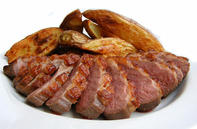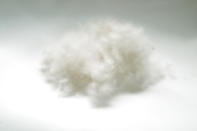Duck meat in South Africa is mostly sold as frozen whole or as fresh birds. While some meat suppliers also offer thigh and breast portions, offal and duck fat, as well as processed duck products such as duck liver pâté, smoked duck, pies and cured duck products.

Other duck-related products include foie gras (duck liver), duck eggs, and duck down and feather products. Ducks are also employed on farms to eat snails and as an eco-friendly way of controlling these pests. Ducks are valuable at protecting smaller poultry such as chickens from rats and other small predators.
Processing Ducks for Meat
Ducks are slaughtered in chicken (technically ‘poultry’) abattoirs but would require slight adaptation in slaughtering equipment due to their heavier weight. The only challenge in slaughtering ducks (or other waterfowl) in comparison to chickens is that they have pin feathers which are lodged deeply in the skin. The scalding and plucking machine in a poultry abattoir may not remove duckpin feathers completely and manual plucking of leftover pin feathers and removal of the little bit of duck down are sometimes needed.
The slaughtering process involves hanging, shock, scalding tank, de-feathering, evisceration (the removal of internal organs), portioning (if required) and packaging. Whole ducks are vacuum packed, boxed and sold in both fresh and frozen form.
Ducks can be further processed, portioned and prepared into products such as duck pâté, duck bacon, deboned duck, sausage, and smoked duck.
Duck fat is highly rated for its taste and the mouthfeel it imparts to dishes such as roast potatoes and is often cheaper than butter. The fat is rendered from duck fat and skin produced during slaughtering and portioning. It has a high smoke point which makes it suitable to cook without inducing a burnt flavour or taste.
Duck Eggs
Not only are duck eggs larger than chicken eggs and have a higher proportion of egg yolk, but the shells are also thicker which means a longer shelflife.
The nutritional quality of an egg depends on what the animals are fed. Duck farming is often in free-range systems where ducks are exposed to the sun, the vitamin D content may be higher than indoor-fed animals.
Duck eggs are also considered superior for baking due to the higher protein and higher fat content of the yolk content but a lower water content means that it may become rubbery when overcooked.
Duck Feather Farming in South Africa

Ducks are specially farmed for feather and down production.
Down is light, fluffy filaments that form the undercoating of goose, duck or swans’ bodies and is used as an insulating stuffing for clothes and bedding. Duck body feathers are coarser and are used to stuff pillows, cushions, clothes and other products.
There are three methods to remove down and body feathers from ducks: post mortem (after slaughter), gathering feathers from where it was shed (during moulting) and live-plucking. Live plucking of duck feathers, which is standard practice in factory farms worldwide, often causes the animal’s skin to tear and is done every six to seven weeks.
Post mortem harvesting of duck feathers and down is not practical. As presented by South African regulations, abattoirs - where ducks are slaughtered, must discard animal waste, including blood and feathers.
What is Foie Gras?

Foie gras literally means ‘fat liver’ and is the liver of ducks (or geese) that was fattened to enable the fast accumulation of body fat resulting in an enlarged liver. Before migration, waterfowl such as ducks would gorge themselves to fatten their livers, which would supply energy during their long migrations.
In modern farming, the hand-feeding of soaked wheat and figs similar to what the ancient Greeks did, was replaced by a feeding tube. The animals are force-fed corn twice a day for almost two weeks through a feeding tube in a process called ‘gavage’. Birds are often kept in tiny cages, unable to bathe or groom themselves. This practise is banned in many countries, including South Africa.
After slaughtering of the force-fed ducks, the enlarged liver is then prepared as is, canned or made into a mousse or most often foie gras pâté.
By Marinda Louw
For bulk or Duck Products export enquiries please use the enquiry link below.